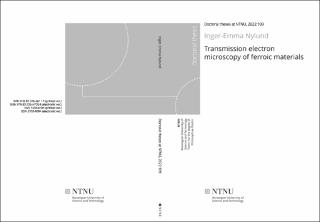| dc.contributor.advisor | Einarsrud, Mari-Ann | |
| dc.contributor.advisor | Vulllum, Per | |
| dc.contributor.author | Nylund, Inger-Emma | |
| dc.date.accessioned | 2022-04-26T14:07:17Z | |
| dc.date.available | 2022-04-26T14:07:17Z | |
| dc.date.issued | 2022 | |
| dc.identifier.isbn | 978-82-326-6720-8 | |
| dc.identifier.issn | 2703-8084 | |
| dc.identifier.uri | https://hdl.handle.net/11250/2992892 | |
| dc.description.abstract | Materials science has the last few decades been advancing by an increasing insight in structure and local chemical composition at the sub-nanometre scale. In this context, the transmission electron microscope (TEM) has proved to be an indispensable tool due to its spatial resolving powers. Using electrons, rather than X-rays, to study ferroelectric materials also has the advantage of the strong interaction between the electrons and matter, which can reveal the presence of a non-centrosymmetric crystal structure, a prerequisite for ferroelectric properties. In this thesis work, three structurally complex ferroelectric materials were studied by TEM, taking advantage of the possibility to perform imaging, diffraction, and spectroscopy within the same instrument.
The three materials systems investigated were ferroelectric BaTiO3 films, tetragonal tungsten bronzes (TTB) with various chemical compositions, and improper ferroelectric Gd2(MoO4)3. The BaTiO3 films were deposited on three differently oriented SrTiO3 substrates and demonstrated to be of high quality considering the chemical solution deposition method which was applied to synthesize them. Importantly, all the films showed an epitaxial orientation relation to the substrate, where misfit dislocations were introduced at the substrate-film interface due to the lattice mismatch between the two materials. A thorough investigation of the misfit dislocations was performed, demonstrating that strain in the films were completely relaxed by the dislocations. Among the TTBs K4Bi2Nb10O30 and Rb4Bi2Nb10O30 were investigated by convergent-beam electron diffraction (CBED) to determine the crystal symmetry. They were revealed to belong to the P4/mbm space group. Moreover, a systematic study of cation intermixing at different lattice sites in the TTB structure were investigated in Ba4A2Nb10O30 (A=Na, K, Rb) by scanning TEM (STEM) combined with energy-dispersive X-ray spectroscopy (EDS). Combined with X-ray diffraction (XRD), the intermixing was determined to rely on the Shannon ionic radii of the constituent elements. Lastly, high quality STEM images were obtained for the beam sensitive improper ferroelectric Gd2(MoO4)3, where the goal was to obtain the polarization orientation from atomically resolved images. However, because of the minor structural differences between the two polarization states in Gd2(MoO4)3, this turned out to be a challenge. This motivated a thorough study of the improper phase transition of Gd2(MoO4)3 by temperature dependent XRD. This study revealed different critical behavior for different cations across the phase transition, which may lead to a better understanding of the emergence of polarization in Gd2(MoO4)3 and improper ferroelectric materials in general.
The work presented in this thesis has demonstrated that the TEM is a very useful tool in the study of ferroic materials. Local variation in the structure and chemistry at an atomic scale were investigated in oxide films as well as bulk materials, which would have been difficult to obtain by other experimental techniques. Determination of the centrosymmetric crystal symmetry of two compounds, previously not determined, was also demonstrated by CBED. However, when the structural variations between two domains became miniature, on the order of picometers, or when specimen damage occurred by the incident high-energy electron beam, alternative characterization techniques, such as XRD provided useful information, demonstrating an important feature of modern materials science, that a combination of experimental techniques is essential in order to advance the field. | en_US |
| dc.language.iso | eng | en_US |
| dc.publisher | NTNU | en_US |
| dc.relation.ispartofseries | Doctoral theses at NTNU;2022:109 | |
| dc.relation.haspart | Paper 1:
Nylund, Inger-Emma; Ræder, Trygve Magnus; Vullum, Per Erik; Grande, Tor.
Epitaxial (100), (110), and (111) BaTiO3 films on SrTiO3 substrates — A transmission electron microscopy study. Journal of Applied Physics 2021 ;Volum 129.(9)
https://doi.org/10.1063/5.0045011 | |
| dc.relation.haspart | Manuscript 1:
Nylund, I.-E., Zeiger, C. R., Peng, D., Vullum, P. E., Walker, J., Einarsrud, M.-A.,
Grande, T.
Exploring the role of Bi 6s lone pair in tetragonal tungsten bronzes
A4Bi2Nb10O30 (A=Na, K, Rb) | |
| dc.relation.haspart | Manuscript 2:
Nylund, I.-E., Løndal, N. S., Walker, J., Vullum, P. E., Einarsrud, M.-A., Grande, T.
Cation disorder in Ba4M2Nb10O30 (M=Na, K, Rb) tetragonal tungsten
bronzes | |
| dc.relation.haspart | Manuscript 3:
Nylund, I.-E.
Scanning transmission electron microscopy of the improper ferroelectric
Gd2(MoO4)3 | |
| dc.relation.haspart | Paper 2:
Nylund, Inger-Emma; Tsoutsouva, Maria; Grande, Tor; Meier, Dennis.
Observation of cation-specific critical behavior at the improper ferroelectric phase transition in Gd2(MoO4)3. PHYSICAL REVIEW MATERIALS 2022 ;Volum 6.(3)
https://doi.org/10.1103/PhysRevMaterials.6.034402 | |
| dc.title | Transmission electron microscopy of ferroic materials | en_US |
| dc.type | Doctoral thesis | en_US |
| dc.subject.nsi | VDP::Technology: 500::Materials science and engineering: 520 | en_US |
| dc.description.localcode | Digital fulltext is not available | en_US |

